A few months ago I was introduced to the incredible Zero Waste Home. I was blown away by how all of the landfill garbage of a San Francisco 4 member family fit into a tiny jar. About a year before I had read about a young woman in NYC who didn't create any landfill trash. The protagonists of these stories, Bea Johnson and Lauren Singer respectively, as well as others, have been very inspiring to me. They've put what I aspire to into practice and shared their insights. Bea’s tips are super concrete and concise and I love how Lauren’s Zero Waste alternatives really make this lifestyle look so aesthetically pleasing.
Whereas Permaculture’s Ethics of Earth Care, People Share and Fair Share guide my intentions, I’ve found they are well complemented with what Bea calls "the 5 R’s", practical fundaments to this zero waste aspiration:
I felt I practiced these to a rather great extent, but there was so more I could do: reducing my waste more mindfully than ever before became one of my 2016 resolutions. Moving to Los Angeles in January for 3 months gave me fresh start. Since then I've established some systems that have accelerated my zero waste transition. In this blog I want to share with you what those systems are and what I have learnt in the process!
Lauren’s 1st step to Zero Waste is to evaluate what sort of trash you produce in your daily routine. I realized the trash I produce mostly came from 4 categories: the kitchen, eating outside, the bathroom and home cleaning. Her second step is to transition to Zero waste by "downsizing and properly disposing unnecessary things" and here's how I've done it for my 4 categories:
Whereas Permaculture’s Ethics of Earth Care, People Share and Fair Share guide my intentions, I’ve found they are well complemented with what Bea calls "the 5 R’s", practical fundaments to this zero waste aspiration:
- “Refuse what you do not need
- Reduce what you do need
- Reuse what you consume
- Recycle what you cannot refuse
- Rot (Compost) the rest.”
I felt I practiced these to a rather great extent, but there was so more I could do: reducing my waste more mindfully than ever before became one of my 2016 resolutions. Moving to Los Angeles in January for 3 months gave me fresh start. Since then I've established some systems that have accelerated my zero waste transition. In this blog I want to share with you what those systems are and what I have learnt in the process!
Lauren’s 1st step to Zero Waste is to evaluate what sort of trash you produce in your daily routine. I realized the trash I produce mostly came from 4 categories: the kitchen, eating outside, the bathroom and home cleaning. Her second step is to transition to Zero waste by "downsizing and properly disposing unnecessary things" and here's how I've done it for my 4 categories:
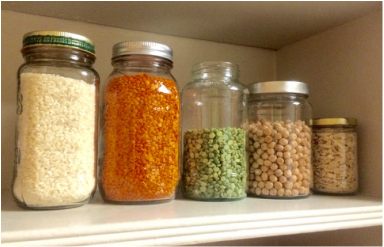
Kitchen
About half of the waste produced in a typical urban kitchen is organic, and thus compostable and thus not waste but preciousness. What is not compostable is food packaging, some of which is reusable and most is recyclable (if the facilities exist). Working around that packaging is what the Zero Waste game is all about. When I got to LA, I made sure to explore what food purveyors were nearby me: I spotted groceries with refill stations and farmer’s markets. I now buy cereals (rice, oats), seeds, nuts, legumes (lentils, chickpeas, beans) and dried fruit in bulk and in large ziploc bags I bring with me to the store which I then transfer into jars at home (bringing glass jars to the store was very inconvenient to me as I walk or bike to the store, and I plan to give the few ziploc bags I use a long and useful life with me, ideally these will be replaced by cloth bags but the ziploc bags were already in my apartment when I got here). I built a jar stock by buying jar contained products that I consume anyway instead of buying new glass jars. They started to accumulate slowly and now I can transition into making those products on my own (e.g. tomato sauces and pickles).
For fresh produce, it seems that people think fruits and veggies HAVE TO be in plastic bags from the store to the house. The same way you don’t need to print a boarding pass, there is no need for putting a lettuce head or 5 apples in a plastic bag, that practice is outdated. There’s been an effort to remove plastic grocery bags, but somehow the thin plastic bags for fresh produce remain uncontested (biodegradable plastic? hmm I trust reusable cloth bags or nothing at all as the way to go). Intentions to not use plastic bags are often simply defeated by unforeseen trips to the grocery store. I always carry a cloth bag with me in case I go groceries without going home first; it always ends up being handy! For whatever product that cannot be found without packaging, remember that for the same amount of product, a single large package is less trash than many small packages (e.g. consider this when buying staples like olive oil or vinegar). I have reused jars, yogurt plastic containers, and cans for all sorts of containing purposes.
About half of the waste produced in a typical urban kitchen is organic, and thus compostable and thus not waste but preciousness. What is not compostable is food packaging, some of which is reusable and most is recyclable (if the facilities exist). Working around that packaging is what the Zero Waste game is all about. When I got to LA, I made sure to explore what food purveyors were nearby me: I spotted groceries with refill stations and farmer’s markets. I now buy cereals (rice, oats), seeds, nuts, legumes (lentils, chickpeas, beans) and dried fruit in bulk and in large ziploc bags I bring with me to the store which I then transfer into jars at home (bringing glass jars to the store was very inconvenient to me as I walk or bike to the store, and I plan to give the few ziploc bags I use a long and useful life with me, ideally these will be replaced by cloth bags but the ziploc bags were already in my apartment when I got here). I built a jar stock by buying jar contained products that I consume anyway instead of buying new glass jars. They started to accumulate slowly and now I can transition into making those products on my own (e.g. tomato sauces and pickles).
For fresh produce, it seems that people think fruits and veggies HAVE TO be in plastic bags from the store to the house. The same way you don’t need to print a boarding pass, there is no need for putting a lettuce head or 5 apples in a plastic bag, that practice is outdated. There’s been an effort to remove plastic grocery bags, but somehow the thin plastic bags for fresh produce remain uncontested (biodegradable plastic? hmm I trust reusable cloth bags or nothing at all as the way to go). Intentions to not use plastic bags are often simply defeated by unforeseen trips to the grocery store. I always carry a cloth bag with me in case I go groceries without going home first; it always ends up being handy! For whatever product that cannot be found without packaging, remember that for the same amount of product, a single large package is less trash than many small packages (e.g. consider this when buying staples like olive oil or vinegar). I have reused jars, yogurt plastic containers, and cans for all sorts of containing purposes.
My recycling has mostly milk and pasta cartons or glass bottles (some of which are refundable). If not much, paper and cardboard can go into the compost. My non-compostable and non-recyclable trash that is left is typically fresh produce tags, butter wraps, cheese wraps, bread bags, and other foods bags I can’t find in at the refill station (e.g. bulgur, coconut flakes, chocolate chips). I now only buy loose leaf tea. So what is left is not much and recycling has gone down as well! Steps forward would be to buy bread at the bakery without it being readily packaged, getting cheese directly from the counter, and find a place that sells milk and yogurt in glass and refill stations for wine and beer amongst others. Even more forward steps would be to make my own bread, yogurt and beer. But that is when practicability towards zero waste would push its edge for me: future steps in the process. For now, I have started to make my own humus, granola and energy-balls (for my 3pm sweet craving) that I used to buy packaged before.
However most importantly, the main lesson learned I want to share is that there were lots of waste reduction actions within my comfort zone: slight tweaks of my routine that were no extra effort but convenient, cheap, healthy and beautiful even!
Wherever your comfort boundaries are within your day to day life, evaluate what’s easily doable for you and get on board with those things first! Reducing your waste is a process that takes iterations of intention, planning, action and assessment.
However most importantly, the main lesson learned I want to share is that there were lots of waste reduction actions within my comfort zone: slight tweaks of my routine that were no extra effort but convenient, cheap, healthy and beautiful even!
Wherever your comfort boundaries are within your day to day life, evaluate what’s easily doable for you and get on board with those things first! Reducing your waste is a process that takes iterations of intention, planning, action and assessment.
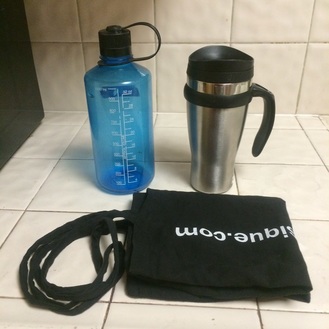 On-the-go essentials for life
On-the-go essentials for life Eating outside
Most astonishing garbage production on an individual basis happens when we order food to go. The worst is when people order to go when they actually stay and had the option to say ‘for here’. Making my own lunch not only creates zero waste but saves a lot of money and is to my taste. I have adopted the habit of making it so it no longer feels time consuming. Always making extra portions for dinner or preparing a big grain based salad once a week is simply part of my routine. When those things didn’t happen, the occasional quick sandwich prep is really not a big deal. The glass jars to go are too heavy for me, so I’ve stuck to my good quality tupperware’s, which unfortunately will be waste in the long-term if non-recyclable. Should I even mention reusable water bottles and coffee/tea mugs? Common’ its 2016.
Most astonishing garbage production on an individual basis happens when we order food to go. The worst is when people order to go when they actually stay and had the option to say ‘for here’. Making my own lunch not only creates zero waste but saves a lot of money and is to my taste. I have adopted the habit of making it so it no longer feels time consuming. Always making extra portions for dinner or preparing a big grain based salad once a week is simply part of my routine. When those things didn’t happen, the occasional quick sandwich prep is really not a big deal. The glass jars to go are too heavy for me, so I’ve stuck to my good quality tupperware’s, which unfortunately will be waste in the long-term if non-recyclable. Should I even mention reusable water bottles and coffee/tea mugs? Common’ its 2016.
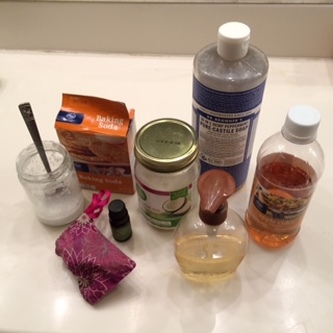 My bathroom Zero Waste Transition essentials: toothpaste, shampoo, conditioner and soap overlapping ingredients (baking soda, pepermint essential oil, cocunut oil, castile soap, apple cider vinegar) and tools + diva cup
My bathroom Zero Waste Transition essentials: toothpaste, shampoo, conditioner and soap overlapping ingredients (baking soda, pepermint essential oil, cocunut oil, castile soap, apple cider vinegar) and tools + diva cup Bathroom
Wow, all my special thanks go to baking soda providers and menstrual cup companies! I’ve switched my regular toothpaste to a home made one (baking soda, coconut oil, peppermint essential oil and water mixed into a paste and stored in a cute-looking jar). More recently I’ve replaced shampoo with a baking soda and water mix (1 cup of water for 1 tbsp of baking soda). For conditioner, apple cider vinegar with water (1 cup of water for 1 tbsp of acv + 2 drops of peppermint essential oil) and occasionally a tiny bit of coconut oil that I rinse out, have worked all right. The toothpaste change has gone without trouble, however new shampoo and conditioner love has yet to grow… Liquid castile soap has become a staple for life: different soap for hands, for body, for dogs, or for dishes, floors and sinks, never again! I refill squishy liquid soap containers with it for the bathroom and kitchen (yep, same stuff for hands and dishes). Baking soda also works great to clean facial pores; and coconut oil for makeup removal. I haven’t explored making my own deodorant or facial cream yet and I still have to get a safety razor. Unpackaged toilet paper is a tough one.
Wow, all my special thanks go to baking soda providers and menstrual cup companies! I’ve switched my regular toothpaste to a home made one (baking soda, coconut oil, peppermint essential oil and water mixed into a paste and stored in a cute-looking jar). More recently I’ve replaced shampoo with a baking soda and water mix (1 cup of water for 1 tbsp of baking soda). For conditioner, apple cider vinegar with water (1 cup of water for 1 tbsp of acv + 2 drops of peppermint essential oil) and occasionally a tiny bit of coconut oil that I rinse out, have worked all right. The toothpaste change has gone without trouble, however new shampoo and conditioner love has yet to grow… Liquid castile soap has become a staple for life: different soap for hands, for body, for dogs, or for dishes, floors and sinks, never again! I refill squishy liquid soap containers with it for the bathroom and kitchen (yep, same stuff for hands and dishes). Baking soda also works great to clean facial pores; and coconut oil for makeup removal. I haven’t explored making my own deodorant or facial cream yet and I still have to get a safety razor. Unpackaged toilet paper is a tough one.
 My home cleaning Zero Waste Transition all-in-one musts: ideally bulk-bought white vinegar and castile soap + refillable handy containers
My home cleaning Zero Waste Transition all-in-one musts: ideally bulk-bought white vinegar and castile soap + refillable handy containers Home cleaning
I’ve kept a spraying container that I refill with white vinegar. I use it to clean kitchen and bathroom surfaces (countertops, mirrors, toilet, windows) with old socks and rags that now have a new life. Liquid castile soap for washing surfaces is great as well. I haven’t explored too much the infinite home cleaning functions of baking soda, but that’s a whole new world! Steps forward include transitioning into bulk-bought or homemade detergents. Non-plastic substitutes for tools like buckets or gloves are tough ones as well, so valuing and taking good care of them is important.
I haven't refused the use of plastic for the essentials in my pictures: in my transition I've first largely reduced the consumption of other plastics and these are left ones that are very handy and reusable. Their total elimination is further down the line.
I’ve kept a spraying container that I refill with white vinegar. I use it to clean kitchen and bathroom surfaces (countertops, mirrors, toilet, windows) with old socks and rags that now have a new life. Liquid castile soap for washing surfaces is great as well. I haven’t explored too much the infinite home cleaning functions of baking soda, but that’s a whole new world! Steps forward include transitioning into bulk-bought or homemade detergents. Non-plastic substitutes for tools like buckets or gloves are tough ones as well, so valuing and taking good care of them is important.
I haven't refused the use of plastic for the essentials in my pictures: in my transition I've first largely reduced the consumption of other plastics and these are left ones that are very handy and reusable. Their total elimination is further down the line.
Two days ago, I launched my Zero Waste month challenge. The challenge consists on keeping all the non-recyclable, non-reusable, non-compostable waste (land fill waste) in a jar for a month. The point of the exercise is to become aware of the volume and type of trash you produce. The idea is to have that 'zero garbage switch' on in the mind for a month to catalyze the design of systems that allow a transition towards a drastic waste reduction. Wanna join me?
A Zero Waste Transition is a great exercise for becoming more self-reliant; the process of replacing things one consumes by things one produces is a fun journey that Permaculture provides a guiding framework for.
I hope that the (slightly sassy) insights from my zero waste transition are useful to you, and on that note, I leave you with these life mantras:
Happy Zero Waste Transition!
Anna
PS: "I think having land and not ruining it is the most beautiful art that anybody could ever want to own." - Andy Warhol
A Zero Waste Transition is a great exercise for becoming more self-reliant; the process of replacing things one consumes by things one produces is a fun journey that Permaculture provides a guiding framework for.
I hope that the (slightly sassy) insights from my zero waste transition are useful to you, and on that note, I leave you with these life mantras:
- Waste exits only when it is wasted
- In nature the waste of one organism is the food of another one
- The concept of waste is essentially a reflection of poor design
Happy Zero Waste Transition!
Anna
PS: "I think having land and not ruining it is the most beautiful art that anybody could ever want to own." - Andy Warhol

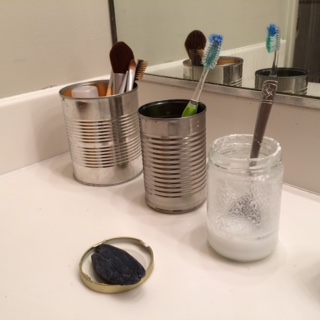

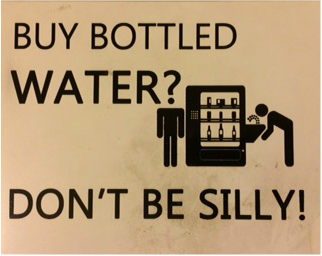
 RSS Feed
RSS Feed
